Key Takeaways
- Health Risks of Fiberglass: Fiberglass used in mattresses, primarily as a fire retardant, can pose health risks if it escapes from the mattress cover. These risks include skin and eye irritation, as well as the potential for respiratory problems if fibers are inhaled. It’s important to take precautions to prevent fiberglass exposure.
- Identifying Fiberglass in a Mattress: You can identify whether a mattress contains fiberglass by looking for signs such as a “Do Not Remove Cover” tag, the mattress being “Made in China,” or an unusually low price for the mattress. Cheaper memory foam or all-foam mattresses are also more likely to contain fiberglass.
- Cleaning and Prevention: If you suspect fiberglass has escaped your mattress, you should take steps to clean and address the issue. This includes wearing protective gear, sealing any damaged areas, and properly disposing of the mattress.
Fiberglass can irritate and seriously harm our health. Mattresses have layers of fiberglass that work as fire retardants, stopping the mattress from catching fire during emergencies. Using fiberglass makes mattresses cheaper, but we need to think about whether the health risks are worth it.
If you accidentally take off the mattress cover from your mattress, or worse, if you have a low-quality mattress with a tin and poorly constructed cover, you might have a problem with fiberglass contamination. It’s definitely an unpleasant situation to deal with, as the fiberglass can spread throughout the home if you’re not careful. Thankfully, there are a few simple steps you can follow to fix the problem. Here’s how to clean fiberglass from a mattress.
Understanding Fiberglass
Fiberglass, sometimes called glass fiber or glass wool when reading the mattress tag, is a special material made by combining reinforced plastic and glass fibers. It has amazing qualities: it can prevent fires, it’s strong, lightweight, and can be shaped into any desired form easily.
One way fiberglass is used is in home insulation. You may have noticed that fluffy material resembles cotton candy on attic walls. That’s fiberglass insulation! It helps maintain the temperature inside a building, making it more energy-efficient. Another interesting use of fiberglass is in mattresses to meet U.S. mattress flammability standards.
Some mattress companies include fiberglass fibers on the inner cover of a mattress because it acts as an excellent fire barrier. Additionally, fiberglass is more affordable compared to other materials that serve the same purpose. However, it’s important to remember that while fiberglass has its advantages, we should be aware of the health risks associated with fiberglass exposure.
Best Mattresses Without Fiberglass
Quick Guide: A 30-Second Summary
| Best Mattress Without Fiberglass Overall | Amerisleep AS3 |
| Best Firm Mattress Without Fiberglass | Amerisleep AS2 |
| Best Soft Mattress Without Fiberglass | Amerisleep AS5 |
| Best Latex Mattress Without Fiberglass | Amerisleep Organica |
At Amerisleep we use a natural mineral to provide flame resistance for our main line of mattresses, while the Organica relies on organic wool for fire protection. All Amerisleep mattresses ship free and come with a 100-night sleep trial and a 20-year warranty.
The Potential Dangers of Fiberglass
Even the tiniest leak can pose a high risk of fiberglass exposure. Verified Source National Library of Medicine (NIH) World’s largest medical library, making biomedical data and information more accessible. View source The glass fibers in fiberglass particles are incredibly small, and even a tear on the mattress cover can cause a lot of them to escape. But why is fiberglass leak so dangerous?
Imagine cutting your finger on a piece of broken glass while washing dishes. Ouch, right? Now imagine that the broken glass is smaller than a speck of sugar and multiply that by a thousand. This tiny and lightweight glass-reinforced plastic can become airborne. Not only can you come into contact with them while lying on the mattress, but you can also inhale them or get them in your eyes, ears, and mouth.
The most common symptoms of fiberglass contamination are skin and eye irritations. However, there have been reports of glass fibers reaching as far as a person’s lungs, causing problems for the respiratory system. In some cases, surgery has been necessary to remove larger glass fibers and prevent serious health risks.
We don’t share this information to scare you, as not all fiberglass mattresses tear easily, and a fiberglass fire barrier is safe to sleep on as long as it remains within the mattress. However, the risks will always be present. So it’s important to understand what the worst-case scenario may be.
Where Fiberglass Is Found in Mattresses
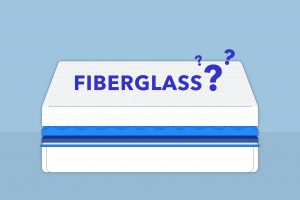 Manufacturers ensure that fiberglass is not placed on the outer surface of the mattress, where we may directly touch it. Instead, they use it inside the mattress’s inner cover. Usually, fiberglass shards are woven into a fire sock, which covers the cushioning and supportive materials inside.
Manufacturers ensure that fiberglass is not placed on the outer surface of the mattress, where we may directly touch it. Instead, they use it inside the mattress’s inner cover. Usually, fiberglass shards are woven into a fire sock, which covers the cushioning and supportive materials inside.
Fiberglass plays a crucial role. It helps prevent the mattress from catching fire by serving as a protective layer beneath the outer covering. All mattresses made in the U.S. must meet mattress flammability standards and resist ignition for a set period of time.
In case of a fire, especially in mattresses made of synthetic poly-foams, the fire can rapidly spread and become hazardous. This is why fiberglass is commonly used in many memory foam mattresses that are made to be affordable. It acts as a barrier, slowing down or even acting as a mattress flame retardant, thus providing an additional layer of protection while we sleep. Yet the material is cheap to produce, so manufacturers won’t break the bank.
Steps for Cleaning Fiberglass from a Mattress
 Properly cleaning up fiberglass in your home requires turning off any air conditioning or heating systems (HVAC system), including window units, mini splits, or central AC. These systems circulate the air and can spread the fiberglass particles throughout your space.
Properly cleaning up fiberglass in your home requires turning off any air conditioning or heating systems (HVAC system), including window units, mini splits, or central AC. These systems circulate the air and can spread the fiberglass particles throughout your space.
Then, put on goggles, protective gloves, and a respirator mask. For affordability, you can use goggles and a half-face respirator. However, if you want maximum protection for your eyes and lungs and dislike foggy goggles, a full-face mask respirator is recommended.
Make sure to get P100 particulate filters, which are specifically designed for use with fiberglass. It is essential to wear a protective suit to shield your skin and clothing from fiberglass. This is the same type of suit used by professionals.
We recommend choosing a suit with attached booties to prevent contamination of your shoes, as cleaning them can be challenging otherwise. To avoid fiberglass entering the breaks of the outfit, use duct tape to seal the armholes where your wrists meet the suit.
With the air conditioner turned off and the use of a protective suit, it is important to be aware that you may feel hot during the cleanup process. Take regular breaks and clean up in stages to prevent the risk of heat stroke. It is crucial to exercise caution throughout the process.
Consider exploring options such as renting an Airbnb or staying with friends or family for a week while completing the cleanup to ensure a safe environment.
HEPA Air Purifiers
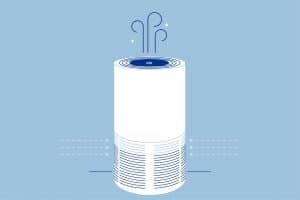 Fiberglass dust and particles have a very small size, as little as 1 micron. To efficiently eliminate these particles from the air and safeguard your lungs, we suggest using an air purifier with a HEPA filter. It is crucial to purchase an air purifier that is equipped with a HEPA filter and keep it operating in your home to effectively cleanse the air since there is airborne fiberglass.
Fiberglass dust and particles have a very small size, as little as 1 micron. To efficiently eliminate these particles from the air and safeguard your lungs, we suggest using an air purifier with a HEPA filter. It is crucial to purchase an air purifier that is equipped with a HEPA filter and keep it operating in your home to effectively cleanse the air since there is airborne fiberglass.
Consider the size of your house when selecting beneficial air purifiers. Different models are designed to purify the air within the specific square footage. Ensure that you have a sufficient number of air purifiers to adequately cover the size of your house. For example, in a 350-square-foot apartment, two HEPA air purifiers are needed continuously while cleaning the apartment of fiberglass.
Identify Fiberglass Leakage
 To find where the glass fibers are coming out, check the mattress cover for any openings or worn-out spots. If you can see the fiberglass underneath, that’s where it’s escaping from. Remember, if you clean the fibers without fixing this spot, they will keep coming out. If you want, you can collect the loose fiberglass in a bag, or move onto the next step.
To find where the glass fibers are coming out, check the mattress cover for any openings or worn-out spots. If you can see the fiberglass underneath, that’s where it’s escaping from. Remember, if you clean the fibers without fixing this spot, they will keep coming out. If you want, you can collect the loose fiberglass in a bag, or move onto the next step.
There’s also the flashlight test for finding mattress fiberglass. Turn off the lights and close any curtains or blinds to make the room as dark as possible. Then, take a flashlight or a strong light source and position it parallel to the surface of the mattress. Make sure the light is pointing directly at the mattress.
Slowly move the flashlight across the surface of the mattress to inspect it, paying close attention to any areas where you suspect fiberglass particles may have escaped. Fiberglass particles are often small and can reflect light, appearing like tiny sparkling or glimmering specks on the mattress or around the bedroom.. Focus on any areas where you see these reflective particles.
Repeat the process. Move the flashlight around the mattress, examining different sections, including the seams, tufting, or areas where the mattress cover may have small holes or tears. If you fear the fiberglass has spread around the room, wave the flashlight around.
Seal off the Mattress
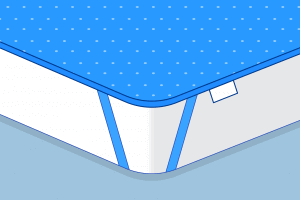 Once you have identified the source of the glass fibers, it is crucial to take the next step and seal off the holes. A great solution for this is to use a mattress encasement with a zipper.
Once you have identified the source of the glass fibers, it is crucial to take the next step and seal off the holes. A great solution for this is to use a mattress encasement with a zipper.
You can easily find these mattress protectors in various online stores or from the brand that manufactures your bedding. The zippered encasement is designed to cover the entire mattress creating a barrier that prevents the fiberglass from spreading inside the mattress and escaping into the air.
Alternatively, if your plan is to remove the mattress from your home as soon as possible, you can consider using mattress bags specifically designed for moving mattresses. These bags provide an extra layer of protection and containment.
Collect Loose Fiberglass in a Bag
Collecting tiny fiberglass fibers in a bag requires caution and proper handling to minimize the risk of fiberglass particles spreading and causing irritation. When dealing with loose fiberglass, it is important to wear protective gear such as disposable gloves, a long-sleeved shirt, pants, and safety goggles to shield your skin and eyes from the tiny sharp fibers.
To begin the collection process, carefully place a large plastic bag or trash bag over the affected area where the loose fiberglass is present. Slowly and gently sweep or scoop the loose fibers into the bag using a broom, dustpan, or any other suitable tool.
Be mindful not to create an excessive disturbance, which can disperse the particles into the air and other circulating broken fiberglass. Once you have collected the loose fiberglass, carefully seal the bag to prevent any fibers from escaping.
Remember to handle the bag with care and dispose of it properly according to your local regulations for hazardous waste or construction materials. Consult with local authorities or waste management facilities to ensure the proper disposal of the bag containing loose fiberglass and any other mattress materials to protect both your health and the environment.
Remove Fiberglass with a Lint Roller
To ensure thorough cleaning and removal of any remaining fiberglass particles, use a lint roller around the bed. Take a lint roller and roll it all around the bed, including your bed frame. The sticky surface of the lint roller will pick up any remaining fiberglass residue that might still be lingering on the mattress surface or bed frame.
After using the lint roller, make sure to dispose of the used lint roller papers with care. It’s important to handle them immediately and dispose of them properly to prevent any fiberglass particles from spreading. By using a lint roller, you can further enhance the cleanliness of your bed’s outer cover and minimize the presence of fiberglass in your sleeping environment.
Vacuum Cleaner with HEPA Filter
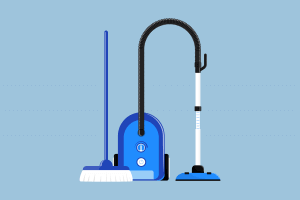 To ensure thorough cleaning and removal of fiberglass particles, use a vacuum cleaner with a HEPA air filter to vacuum the entire bed and bedroom. A vacuum cleaner with a HEPA filter can effectively remove particles as small as 0.3 microns, including any remaining glass fibers. Don’t hesitate to vacuum the area more than once if necessary to ensure all the fiberglass is removed from your bed and bedroom.
To ensure thorough cleaning and removal of fiberglass particles, use a vacuum cleaner with a HEPA air filter to vacuum the entire bed and bedroom. A vacuum cleaner with a HEPA filter can effectively remove particles as small as 0.3 microns, including any remaining glass fibers. Don’t hesitate to vacuum the area more than once if necessary to ensure all the fiberglass is removed from your bed and bedroom.
As an additional tip, while you’re cleaning, it’s a good idea to clean out the filter of your air conditioner as well. This is because the air conditioner may have also collected some glass fibers. By cleaning the filter, you can prevent any potential fiberglass particles from being circulated back into the air, eliminating the risk of inhaling fiberglass.
Properly Dispose of the Mattress
If your mattress is leaking, then it’s probably time to dispose of your mattress. Make sure to wear protective clothing, replace your worn out mattress cover, and use zippered encasement covers instead, preferably one made from reinforced plastic, for proper disposal. It’s important to prevent contaminating the whole neighborhood.
You can look into mattress disposal or mattress recycling services provided by some cities and states. Some may even offer them free of charge (availability may vary depending on your area, so make sure to check).
Replacing with a Fiberglass-Free Mattress
Now, we understand that parting ways with your old mattress can be tough, especially if you’re not able to buy a new one right away due to financial constraints. But there’s no other way to completely get rid of fiberglass from your mattress. It’s something we all need to be aware of for our own well-being, along with other health risks of old mattresses.
While mattresses can be expensive, with smart shopping they won’t break your budget entirely. Even if you won’t compromise on fiberglass-free comfort.
Once you’re in the market for a new mattress, be careful not to fall for greenwashing tactics. Verified Source National Library of Medicine (NIH) World’s largest medical library, making biomedical data and information more accessible. View source Some sellers may use terms like “glass wool” or “glass fibers” to deceive customers, making their mattresses sound more eco-friendly than they actually are. It’s important to be aware and do your research. Choose a mattress brand you can trust to prioritize your health, comfort, and the environment.
You can also keep in mind your fallback option of a sleep trial period. Should you purchase a mattress with fiberglass, a mattress sleep trial gives you a few months to return the mattress, usually for comfort reasons.
However, a risk-free sleep trial should also offer you a refund for fiberglass-related returns and find a new mattress without fiberglass.
When it comes to choosing a mattress, remember to keep an eye out for those misleading terms and make sure you go for a high-quality fiberglass-free mattress. Your comfort and safety are worth it, after all!
Washing Fiberglass from Bed Sheets
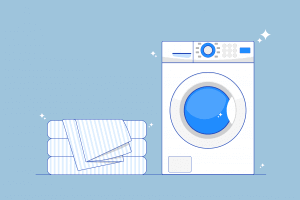 Cleaning fiberglass from any type of bed sheet can be challenging due to the tiny fibers and sharp particles that can stick to the fabric. Some steps can be followed to remove fiberglass particles and maintain the quality of your bedding.
Cleaning fiberglass from any type of bed sheet can be challenging due to the tiny fibers and sharp particles that can stick to the fabric. Some steps can be followed to remove fiberglass particles and maintain the quality of your bedding.
To begin, protect yourself by wearing suitable clothing. Put on disposable gloves, long sleeves, and pants to minimize direct contact with the fibers. Handle the sheets with care and avoid shaking or folding them vigorously, as this can release more fiberglass particles into the air.
Wash the sheets separately from other laundry items. Use warm water and a gentle cycle with an extra rinse to help remove the fiberglass, regardless of your usual washing method or the water temperature recommended on the care symbols. Ensure the washing machine is not overloaded to thoroughly clean the sheets.
After washing the contaminated sheets, run an empty cycle with hot water and detergent to eliminate any remaining fiberglass particles from the machine. Then, dry the sheets with caution. Opt for a low-heat setting or air-dry them to minimize agitation and reduce the release of fibers.
As an additional safety measure, we suggest wiping down surfaces in the laundry area to remove any loose fiberglass particles. Please note that while these steps can help reduce fiberglass contamination, it may be difficult to completely eliminate all fibers. If the sheets remain contaminated or if a significant amount of fiberglass is, we recommend replacing them to ensure safety and comfort.
Identifying Fiberglass in a Mattress
You can identify whether a mattress contains fiberglass by looking out for a few distinct signs. It doesn’t matter what type of mattress it is, whether it’s memory foam, innerspring, or a hybrid mattress, it ultimately depends on the brand. However, fiberglass is commonly used as a flame retardant in all-foam or memory foam mattresses.
“Do Not Remove Cover” Tag
In the investigation we conducted, we found that if a mattress label warns against removing the inner mattress cover, it could be a sign of fiberglass underneath. It is important to take these warnings seriously as fiberglass exposure can have serious health implications.
That said, a non-removable cover is often considered common sense by manufacturers who don’t want their consumers struggling to wrestle a cover fabric back over the bed’s materials. So it’s not necessarily a reason to discount a mattress, but it is wise to proceed with caution.
“Made in China” Label
Pay attention to labels that say “Made in China” or similar. It has been noticed that numerous companies, including mattress manufacturers, depend on China’s manufacturing industry. However, our investigations have revealed that overseas manufacturing standards can be less strict, which can pose health risks for consumers.
Even if a mattress is not produced overseas, it is important to be careful when dealing with brands and mattress companies that do not provide clear information about their production methods and the materials used in their mattresses.
Affordable Price
Exercise caution with low-priced mattresses. Mattress prices that are $100 to $500 for the full standard mattress size range are more likely to contain fiberglass. Cheaper mattresses may employ cost-cutting measures that compromise quality and potentially include hazardous materials.
Affordability does not automatically imply poor quality. However, it is wise to be wary of deals that seem too good to be true, based on our past experiences. Safe budget mattresses do exist, but you need to know what it is you’re buying.
Polyfoam Construction
When considering mattresses, it’s worth noting that not all polyfoam mattresses are made of memory foam. Polyfoam is a less expensive material that may not be as good at getting rid of heat compared to memory foam. Some mattress makers might use polyfoam along with fiberglass and other cheaper materials, especially in more affordable mattresses, to save money.
That’s why it’s crucial to be mindful of each composite material used by mattress brands when looking for an all-foam or memory foam mattress. Not all memory foam mattresses have fiberglass, though, so you don’t necessarily need to go for a latex mattress to rest securely on a fiberglass-free mattress.
Frequently Asked Questions
Should I be worried about mattress fiberglass?
Yes, it is important to be concerned about mattress fiberglass. When a mattress cover or encasement is damaged, the tiny fiberglass particles can be released and become airborne. Inhaling these particles can be harmful to your health, causing irritation to your skin, eyes, and respiratory system.
To protect yourself, it is crucial to take precautions. If you suspect or confirm fiberglass contamination, address the issue promptly for your safety. Use protective gear, like gloves and a mask when handling the mattress, and make sure to seal any damaged areas. Properly clean and dispose of the contaminated mattress to prevent further exposure.
What part of a mattress has fiberglass?
Fiberglass is typically found in the inner layer of a mattress wrapped around its layers, known as the fire sock. The fire barrier underneath the mattress cover is designed to meet fire safety regulations. In some mattresses, fiberglass is used as a component of this fire barrier.
However, it is important to note that not all mattresses contain fiberglass, and the presence of fiberglass can vary depending on the brand and type of mattress. If you have concerns about fiberglass in a mattress, check the product label or contact the mattress manufacturer for more information.
How do I know I’m buying a mattress without fiberglass?
To ensure you are buying a mattress without fiberglass, there are a few steps you can take. Firstly, carefully read the product label and description to see if it explicitly mentions that the mattress is fiberglass-free. Additionally, you can reach out to the manufacturer or retailer and ask them directly about the presence of fiberglass in the mattress.
Another option is to look for certifications that indicate that the mattress has been tested and certified for the absence of harmful substances, including fiberglass. Doing thorough research and asking specific questions will help you make an informed decision and choose a mattress that is free from fiberglass.
How can I protect myself from a fiberglass mattress?
To protect yourself from a fiberglass mattress, there are several precautions you can take. First, consider using a mattress encasement or cover that is designed to prevent the release of fiberglass particles. This acts as a barrier and reduces the risk of exposure.
If you suspect or confirm fiberglass contamination, seal any damaged areas of the mattress and carefully clean or dispose of it following proper guidelines. Regularly maintain and inspect your mattress for any signs of wear or damage to address potential issues early on. By being proactive and taking necessary precautions, you can protect yourself from the potential risks associated with a fiberglass mattress.
How do I know I’ve been exposed to fiberglass?
You can recognize if you’ve been exposed to mattress fiberglass by paying attention to certain signs and symptoms. Common indicators include itching, redness, skin irritation, eyes, or respiratory system. If you experience these symptoms after being in contact with a fiberglass mattress, it’s likely that you’ve been exposed to escaped particles.
Seek medical advice if you have any concerns or if the symptoms persist. Remember to take precautions to minimize exposure to fiberglass, such as a mattress protector for a fiberglass mattress and protective clothing for cleaning up. Maintain a safe environment to prevent further health issues.
Can fiberglass slip through mattress covers?
While fiberglass fibers are small and can be easily airborne, they are not typically designed to slip through mattress covers. However, if there is damage to the mattress cover, such as holes or tears, or if the cover fabric has a loose weave, it is possible for small fibers like fiberglass to pass through.
In such cases, the fiberglass particles may become airborne and potentially cause irritation or discomfort, especially if they come into contact with the skin or are inhaled. If you fear you have a low-quality mattress cover, you can place an extra barrier between yourself and the fiberglass with a mattress protector.
Conclusion
Removing fiberglass that has escaped from a mattress can be challenging. However, effective methods have been discovered to efficiently eliminate these small particles from your home.
It’s crucial to remember that the earlier solutions provide only temporary relief, and as long as a mattress with fiberglass remains in your home, there will always be a risk of exposure. The final step is to replace the mattress after completing the cleanup process. Given the observations and associated risks, we highly recommend promptly selecting a new non-toxic and safe mattress and properly disposing of the old one for complete safety.
About the author
April Mayer is a sleep expert and writer with a degree in exercise physiology. She has dedicated her career to exploring the relationship between sleep and productivity. Her insightful articles, such as "The Surprising Way Your Mood Might Be Messing With Your Productivity" and "Wake Up to More Productive Mornings," have been featured in reputable publications like Forbes, Greatist, Real Homes, Thrillist, Tom's Guide, and Eat This, Not That. With a passion for helping others lead more productive lives through restful sleep, April offers valuable expertise on foods and vitamins for better sleep. As a trusted member of the Early Bird team since March 2020, she continues to provide informative and well-researched content.
View all posts





